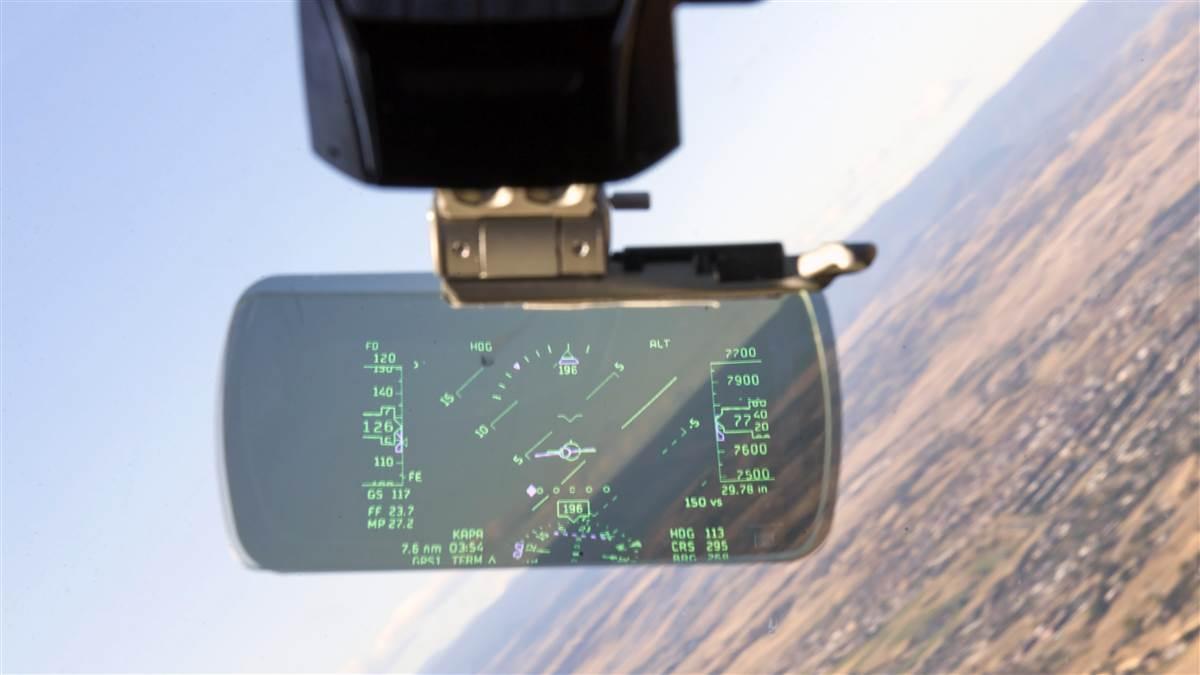First Look: MyGoFlight’s SkyDisplay
Part 23 airplanes finally get a HUD

“This brings Transport-category capabilities into Part 23 aircraft,” says company CEO Charles Schneider. So far, owners of 19 different airplanes have signed up for what MGF calls its SkyDisplay HUD. These airplanes range from piston singles to light jets.
The SkyDisplay takes flight and navigation inputs from an airplane’s ARINC 429 data bus and feeds it to a transparent viewing screen called a combiner. This way, the pilot can look through the combiner and see both the view ahead and the most essential attitude and flight guidance information at the same time. One big advantage of HUDs is that you needn’t move your head up and down when shifting your scan from the windshield to the instrument panel. This helps prevent vertigo during critical phases of flight and keeps your concentration outside the cockpit. This is especially critical when transitioning from instrument to visual flight references when landing out of instrument approaches in low ceilings and visibilities.
The $25,000 SkyDisplay has the same advanced features found on high-end HUDs costing $500,000 or more. The center of the combiner is dominated by a large representation of an attitude indicator, surrounded by airspeed and altitude tapes with trend indicators, a wind arrow, heading and course deviation indicators, as well as data blocks giving groundspeed, fuel flow, and power information. Depending on the phase of flight, some data may be decluttered. For example, on an ILS approach the round CDI depiction goes away, leaving just lateral and vertical scales for localizer and glideslope guidance.
Instead of the command bars familiar to most general aviation pilots, the display uses a circular, magenta flight director cue for heading and course guidance. A second symbol—the flight path marker—is a green symbol that indicates the airplane’s track. To follow a heading or course command from the airplane’s flight director, steer the airplane to center the flight path marker on the flight director cue. This guidance method is common in high-end business jets, and it’s intuitive and easy to use. Simply “put the jelly [the magenta flight director cue] in the doughnut [the flight path marker’s green circle],” to use one colloquialism.
For example, during an ILS approach with heading and nav sources selected, you’d see the flight director cue giving you heading commands as you intercept the final approach course. As the localizer or other nav source centers, the flight director cue switches you to follow the course—along with vertical guidance in the case of precision approaches.
The SkyDisplay differs from those high-dollar, certified HUDs in that it has a nonconformal display. Among other things, this means that the flight path marker doesn’t precisely indicate the airplane’s projected path on the landscape or sky ahead. It will be close, but pilots accustomed to flying a flight path marker centered on a runway threshold will find that it will be several feet off. “In order to keep the system simple and low-cost, we had to sacrifice that small element of accuracy,” Schneider said. “But on the other hand, this system has a wider eyebox [viewing area on the HUD screen]. This means that unlike conformal HUDs, you have more allowable head movement.” Conformal HUDs have a narrow viewing range and require that your eyes be centered straight ahead. Move your head away from their small central viewing areas and you lose the HUD imagery.
A demo flight in MyGoFlight’s Cirrus SR22 proved the SkyDisplay’s utility. The combiner may be smallish, but it gives a great view. The zero-pitch line stands out during steep turns; just keep the flight path marker on the line and your altitude won’t stray. As for instrument work and other navigation chores, all the necessary pitch, bank, power, and guidance information is easy to interpret, and right on the combiner. For precision approaches, there’s even a 3-degree dashed pitch line, which helps back up glideslope commands as you fly down final. For all its attributes, the SkyDisplay is not certified for standalone use; it serves as supplemental information to conventional, panel-mounted instruments.
We used the HUD on all our landings at Denver’s Centennial Airport—MyGoFlight’s home base—and rarely felt the need to look down at the instrument panel. Instead of scanning an entire panel’s worth of real estate, it’s all in focus on the combiner.
Schneider says that the SkyDisplay is very close to earning supplemental type certificate approval. Price of the system is set at $25,000 for initial deliveries. Schneider says that down time for installation should take as little as two days.
Web: mgfproducts.com/pages/hud
Email [email protected]



